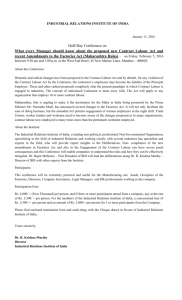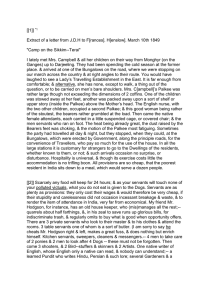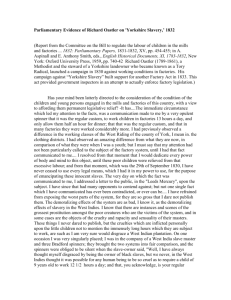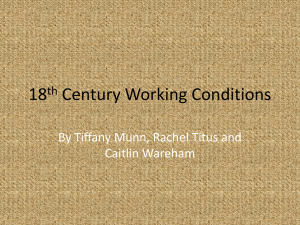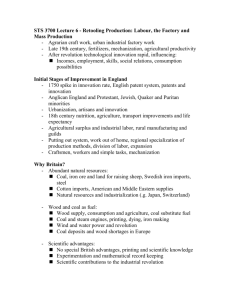Working Conditions in the 1900s
advertisement
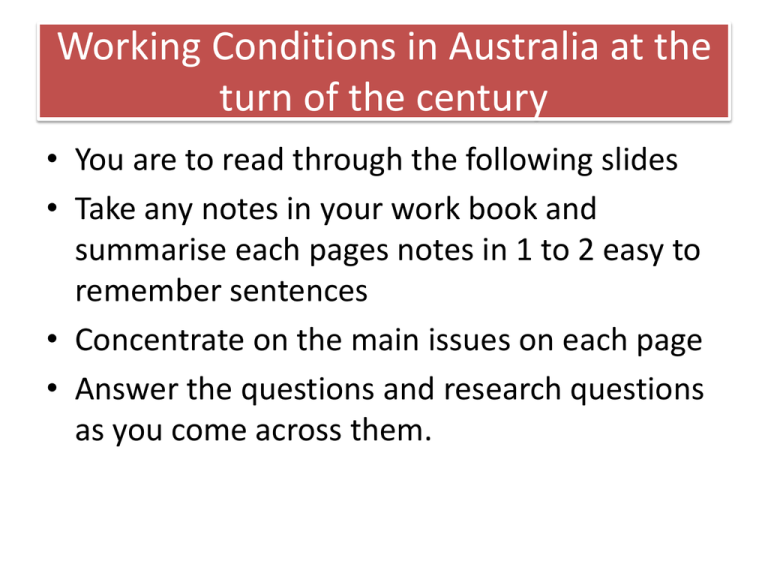
Working Conditions in Australia at the turn of the century • You are to read through the following slides • Take any notes in your work book and summarise each pages notes in 1 to 2 easy to remember sentences • Concentrate on the main issues on each page • Answer the questions and research questions as you come across them. Working Conditions in the 1900s • Many reforms introduced by colonial governments were ignored by employers • Long hours • Little pay • Fear of being sacked for complaining • No government protection • Retire without superannuation Web Quest Activity On the internet look up • 8 hour day factory girls Answer the following 1. Describe the illustration ‘The factory girls of Melbourne’ 2. Why was factory work more attractive than domestic service? Click the link Children 3. How did children’s health suffer? Search these keywords • Women transported National Archives Australia 3. Write down 3 interesting facts about Australian female convicts 4. Browse through the primary sources (find the oil painting of Port Macquarie) Factories • In the cities a large percentage of people worked in factories • Some workers were treated like slaves • Factories with no toilets, no windows • Temperatures could reach over 40 degrees in summer • Working hours from 8 am – 6 pm • Work sometimes continued to 10pm without extra pay • Most workers walked home, some for 5 km Working in Factories • Describe the conditions shown in this source. Why might conditions like these lead to health problems? Labourers • Dangerous sites • Without safety regulations Shops • Hours 9 am to 9 pm on weekdays and 9 – 11pm on Saturday • Not permitted to sit down Labourers What are the main differences between this worksite and modern worksites today??? Child Labour • Even though school was compulsory, it was common for children as young as eight to work in factories, textile mills and in the boot trade • Most would work 60 hr weeks from 7 am – 6pm • Young children used because: - They were cheap labour - Could clean the spaces in machines that were to small for adults (dangerous and some were killed) • Paid 2cents for an hours work compared to 4cents for women • Poor parents relied on children working to provide enough money for the family Female Servants • In 1901 over 20% of all workers were women • Most of these female workers were unmarried • Domestic servants who worked as maids, servants or cooks • Pay ranged from 14 shillings a week for a housemaid and 25 shillings a week for a cook • Some ‘lived in’ and were well treated • Some bosses took advantage of female servants, some servants were seduced and became pregnant, they were then sacked and thrown out with no support. Domestic Labour • Look up domestic labour at the turn of the century • Fine and make note of 4 main points about domestic labour. • Eg. Hrs, pay, conditions etc Rural Workers • Badly treated • Under contract paid one pound per month for every one hundred sheep shorn • If the boss was unsatisfied he simply refused to pay • Buy supplies of the boss often at inflated prices • Strikes in 1890s to protest their conditions that were violent • See sources on Page 14 of text. Melbourne: 8 Hour Day March c.1900 8 Hour Day Marches • Using the preceding images as reference's research the following • What were the marches? • Were they successful? • When and where did they take place? • Who participated in them? • Was anybody opposed to the marches?


